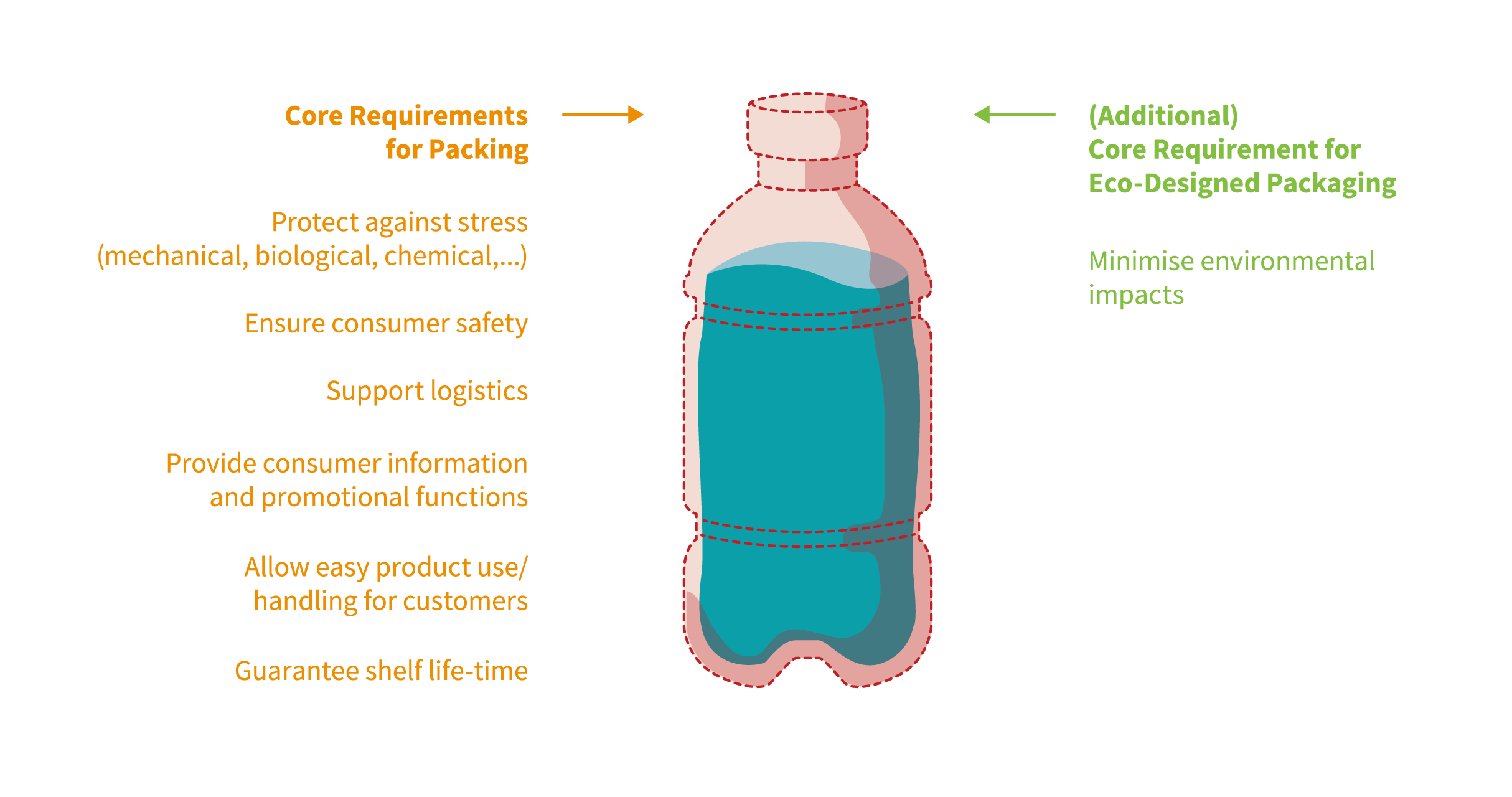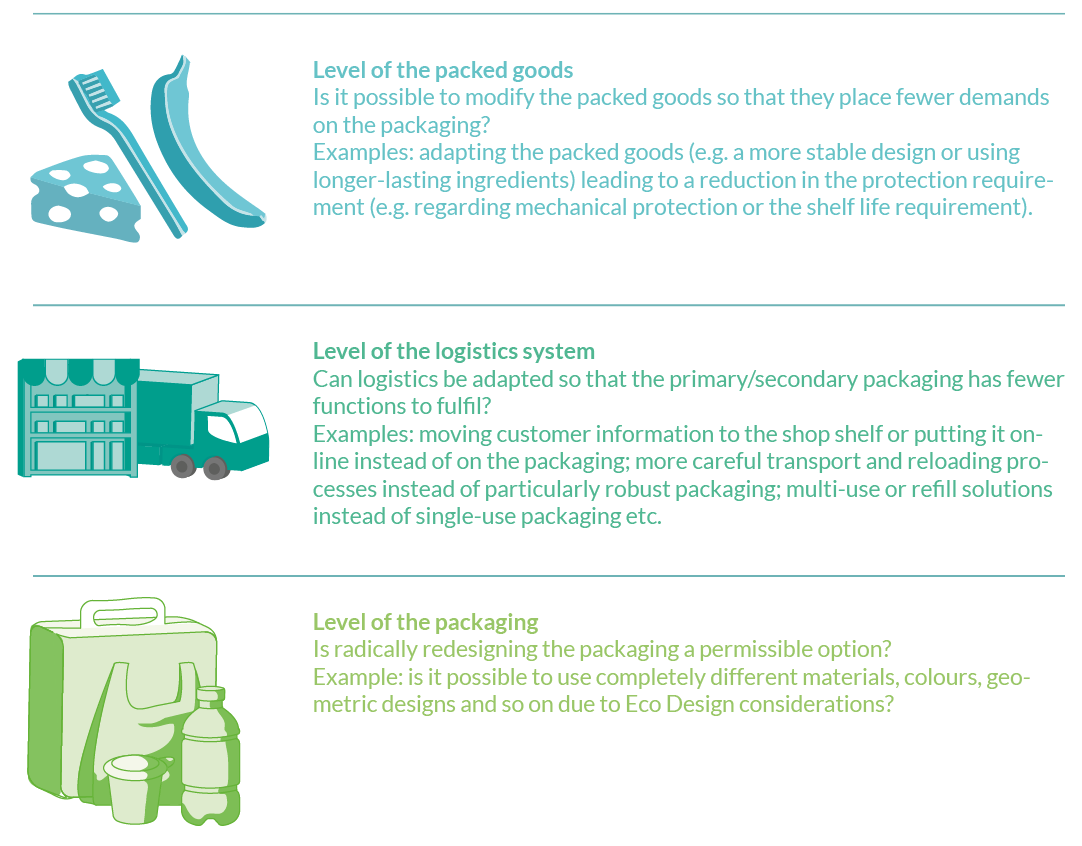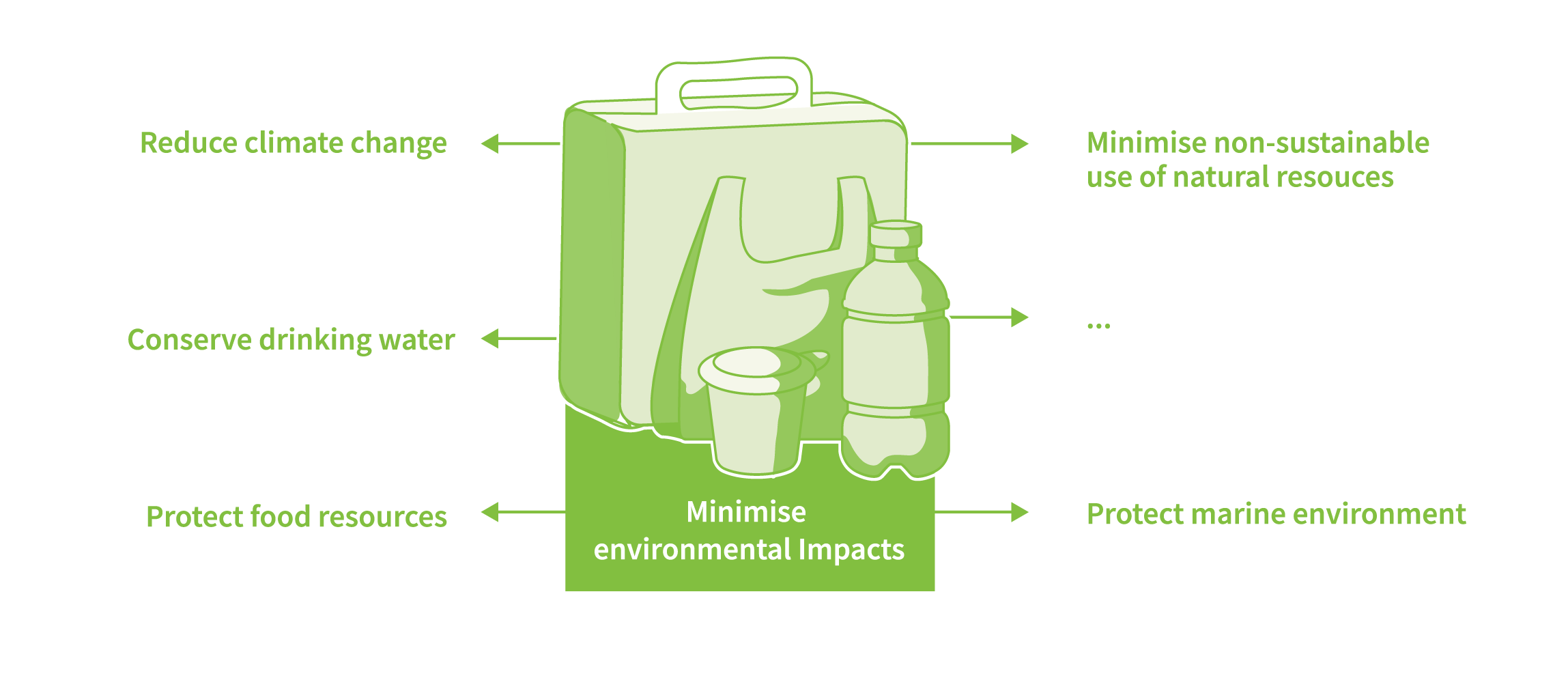ABOUT THESE GUIDELINES
With approximately 14 million tonnes of plastic packaging coming onto the European market each year, plastic has become the material of choice to pack the majority of consumer goods and foodstuffs. Barrier protection, transparency, low weight and competitive costs are just a few of the valued properties of this versatile material. Plastic packaging protects goods during transport, in stores and in the home, playing a vital role in conserving valuable resources and protecting the climate.
In recent years, plastics packaging has come under increasing pressure due to insufficient Waste Management and Recovery solutions around the world that have resulted in large amounts of plastic material remaining unused in landfill or even Littering the environment. “Design for Recycling” is therefore a demand that is increasingly being placed on manufacturers and users of plastic packaging in order to keep plastic permanently in the reusable material cycle. However, there are many more aspects to the design of plastic packaging and, consequently, requirements for recycling-friendly design need to be brought into line and balanced with other important environmental factors and key functions of packaging, above all with product and consumer protection.
The Round Table Management Guidelines for Eco Design of Plastic Packaging aim at highlighting and implementing management procedures, strategies and methods for the development of packaging design in line with the corporate and brand environmental policies. The Guidelines assist senior managers, product managers, marketing directors, packaging developers and designers in the development of modern plastic packaging.
While a number of design guidelines and tools have already been developed in recent years, particularly for design for recycling, the present guidelines focus on communicating a comprehensive understanding of Eco Design to allow an appropriate focus in the early product development phase (ideation phase) as well as the integration of Eco Design into organisational procedures, including ways of resolving conflicts in objectives. In addition, the Guidelines contain a toolbox with references to specialised practical tools for the design and development of environmentally friendly packaging.
The Guidelines have been developed for plastic packaging by the Eco Design of Plastics Packaging Round Table. They are the result of an intensive stakeholder dialogue among experts from all parts of the supply chain, including packaging manufacturers, international brand manufacturers, retailers and recyclers as well as environmental and consumer organisations and scientists, and aim at being as practice-oriented as possible. Although they were developed with a view to Europe, the Guidelines are in principle applicable at a global level. These Guidelines make an important contribution to a Circular Economy in the plastics packaging value chain.
THE BASIC CONCEPT OF ECO DESIGN
The members of the Round Table agreed on the following basic concept as the basis for developing the Guidelines.
Eco Design of plastic packaging:
- Aims to minimise the environmental impacts of plastic packaging and packed goods over their entire life cycle
- Is part of the decision-making process for developing and marketing a packaged product
- Includes a holistic view of the entire packaging system (primary, secondary and tertiary packaging)
- Ranges from incremental product improvements (e.g. material reduction) to process innovations (e.g. optimised goods logistics and waste recycling)
- Addresses Conflicting goals at various levels:
- Between various environmental factors (e.g. using less material versus recycling) as well as
- Between environmental and other factors (e.g. functionality, consumer protection and costs).
ECO DESIGN OF PLASTIC PACKAGING
– FOR WHOM IS IT RELEVANT?
Eco Design of plastic packaging aims to minimise the environmental impacts of plastic packaging and packed goods over their entire life cycle. In order to achieve this, Eco Design must become an integral part of management decision-making concerning the development and marketing of goods and their packaging.
The Round Table Guidelines consist of a number of different elements. The key guidelines describe how to implement Eco Design effectively in the management of packaging projects and how to develop brand-specific environmental strategies for packaging design projects.
Additional elements of the Round Table Guidelines are available online. Instructions with detailed background descriptions, specific checklists for practical packaging development and illustrative examples and a Collection of practical tools, for instance for assessing recyclability, are additional aspects of the Round Table Guidelines.

MARKETING RELEVANCE
Beyond its functional purpose, packaging is also the bearer of marketing messages and is thus an important part of brand communication. While a few years ago environmentally friendly design and sustainability were key messages limited to “green” target groups, most consumers nowadays expect to see this as a natural feature of all quality products and their packaging. A brand image can be seriously damaged if the consumer does not perceive it to be environmentally friendly and sustainable.
POLITICAL RELEVANCE
Plastic packaging is increasingly becoming the subject of critical societal and political discussion. This debate is being fuelled in particular by
- The haunting images of plastic litter accumulating in the oceans and on our coasts.
- Endeavours to establish a circular economy aimed at closing material cycles and thus conserving natural resources and protecting the climate.
TARGET GROUPS
In light of these arguments, Eco Design of plastics packaging is a relevant issue for a broad group of people with different functions in corporations. These Management Guidelines primarily, but not exclusively, address:
Senior management in the packaging, food, consumer goods and retail industries:
Top management is given a brief description of the key strategic decisions to be taken and the procedures that need to be established to create the basis for a meaningful implementation of Eco Design in their organisations.
Product managers, marketing directors and other decision-makers in packaging projects:
These functions are supported in developing a specific Eco Design Strategy for the Packaging Project by a set of possible Eco Design strategy elements addressing the relevant Environmental impact areas and critical questions from interest groups. The four available strategy elements of the Guidelines address various relevant environmental issues and should be selected in line with the relevant corporate and brand strategies.
Packaging developers and designers as well as specialist marketing and consulting agencies:
These target groups will find the necessary background information as well as practical tips for understanding and implementing the details of the selected Eco Design strategy elements. This information includes:
![]() Instructions that provide explanations and detailed background information for the specific approaches to optimisation within the four strategy elements.
Instructions that provide explanations and detailed background information for the specific approaches to optimisation within the four strategy elements.
![]() Checklists asking the most relevant questions for approaching an Eco Design project as such and, more specifically, the different possible areas for optimisation. Their use leads to clearly structured decision-making processes. They also provide assistance in handling conflicts between different environmental objectives as well as with contradictions with other key requirements of packaging design such as consumer protection and cost-effectiveness. Applying the guidelines will not eradicate conflicting objectives but it will help to deal with them in a transparent and sustainable way.
Checklists asking the most relevant questions for approaching an Eco Design project as such and, more specifically, the different possible areas for optimisation. Their use leads to clearly structured decision-making processes. They also provide assistance in handling conflicts between different environmental objectives as well as with contradictions with other key requirements of packaging design such as consumer protection and cost-effectiveness. Applying the guidelines will not eradicate conflicting objectives but it will help to deal with them in a transparent and sustainable way.
![]() Step-by-step practical examples that illustrate potential challenges and appropriate solutions and thus help to translate the information provided into ‘real’ project work.
Step-by-step practical examples that illustrate potential challenges and appropriate solutions and thus help to translate the information provided into ‘real’ project work.
WHAT IS ECO DESIGN OF PLASTIC PACKAGING ALL ABOUT?
ADDRESSING AN ADDITIONAL CORE REQUIREMENT
Packaging plays a fundamental role in the delivery of goods and foodstuffs to consumers.
A key function is to protect the packaged goods against mechanical damage and other stressors such as oxygen, dust and dirt, biological contamination, humidity and temperature in order to maintain perfect functioning and quality of the product including, for instance, guaranteeing a minimum shelf life and the genuine flavour of the product.
In addition, there are several more functions packaging performs, such as
- Allowing safe and easy product use for consumers
- Providing helpful consumer information and promotional messages, and
- Supporting optimised logistics.
To some extent, these functions are subject to legal requirements.
Beyond these “traditional” key requirements, well known to anyone involved in the design and development of packaging, any meaningful attempt at Eco Design needs to include another key requirement in this multi-dimensional set of functions – minimising negative environmental impacts.
Eco Design of plastic packaging includes a holistic view of the entire packaging system (primary, secondary, and tertiary packaging) from incremental improvements to packaging to fundamental system innovations, e.g. establishing return logistics for used packages or setting up recycling systems.
Eco Design of plastic packaging needs to deal with conflicting objectives at different levels. Conflicts may arise between different environmental goals as well as between environmental goals and other key aspects of packaging.
LIFE CYCLES OF PACKAGING AND PACKED GOODS ARE CLOSELY INTERLINKED
As a result of the variety of functions outlined above, today‘s packaging often requires complex and highly specialised products. As with all products, natural resources are used over the entire life cycle, which is something that affects the environment. Impacts occur during feedstock production, processing of the actual packaging material and the packaging itself, the filling/packaging process, during the use of the packaged goods and the collection, sorting and subsequent recycling of the packaging waste.
On the one hand, packaging itself thus has an environmental impact during its own life cycle. On the other hand, it also helps reduce the environmental impacts of packed goods through its protective function.
In the implementation of the different functional requirements in the packaging design process, designers make a variety of decisions that largely determine environmental impacts. The decisions relate to the manner in which functional requirements for the packaging are met, how the materials are selected and how they are combined, which labels and coatings are applied as well as the weight and geometry of the packaging.
 From an environmental protection point of view, the use of natural resources should be minimised as far as possible without compromising protective functions. It must be noted here that the environmental footprint of the Packed good is typically much higher than that of the packaging. With food, for example, packaging accounts for five to ten percent of total energy consumption, while over 90 percent relates to the manufacturing, transport, storage and preparation of the food.
From an environmental protection point of view, the use of natural resources should be minimised as far as possible without compromising protective functions. It must be noted here that the environmental footprint of the Packed good is typically much higher than that of the packaging. With food, for example, packaging accounts for five to ten percent of total energy consumption, while over 90 percent relates to the manufacturing, transport, storage and preparation of the food.
It would be counterproductive from an overall ecological perspective if the necessary protection of the packed goods were impaired as a result of a reduced use of resources for the packaging. If packed goods are damaged, resources used in their production are wasted.
It goes without saying that excessive packaging must also be avoided. Overpackaging designs will Lead to increased resource consumption that is not required for the protection of the packed goods. In addition to an extreme protective function, which is unnecessary under the relevant logistical and usage conditions, overpackaging can also result from excessive requirements in the information and marketing function of packaging.
It should be noted that when packaging designs are being optimised, the entire system of packaging and packed goods (“packaging solution”) must be considered.
ECO DESIGN – MORE THAN JUST CHANGING THE PACKAGING
FUNDAMENTAL QUESTIONS THAT NEED TO BE ADDRESSED
If Eco Design of plastic packaging is viewed as an integral part of innovation and decision-making processes when developing packaging solutions, a number of fundamental questions need to be addressed during these processes:

There is a clear hierarchy among these questions. In most cases, changes to the goods or logistics will have a greater effect on the reduction of the environmental footprint than changes to the actual packaging. In many cases, this applies to improvements in both environmental and economic performance.
FURTHER OPTIMISATION POTENTIAL BEYOND ECO DESIGN
It needs to be emphasised that the implementation of a fully holistic environmental strategy cannot be limited to the Eco Design of the packaging but must also include additional optimisation areas. For example, improving the environmental performance of production facilities (e.g. better Energy Efficiency, lower rate of deficient packaging) or means of transport may often deliver significant environmental impact reductions.
In most companies, however, each of these areas is an issue of separate complex consideration independent of the packaging design, decisions on investment cycles, internal responsibilities and external agreements. In the light if of these practical considerations, the further minimisation of environmental impacts beyond Eco Design is not within the scope of these management guidelines.
REDUCING THE ENVIRONMENTAL IMPACT – A MULTIDIMENSIONAL OBJECTIVE
The overarching goal of Eco Design is to minimise negative environmental impacts. However, this reduction of environmental impacts is a multidimensional objective covering various environmental impact categories such as climate change, loss of Biodiversity and fresh water depletion. These environmental impacts are relevant independent of each other and there is no overarching indicator that can be used to measure them.
EXAMPLES TO MINIMISE ENVIRONMENTAL IMPACTS
 While there is no hierarchy among different environmental impact categories from a scientific point of view, priorities are regularly set either explicitly or implicitly in the socio-political debate. Climate change mitigation, for example, draws on broad social consensus and clear political targets with quantitative indicators. Another subject increasingly at the centre of public debate is the problem of marine littering. Due to a lack of binding political targets and clear metrics to date, it remains rather less clearly tangible, however.
While there is no hierarchy among different environmental impact categories from a scientific point of view, priorities are regularly set either explicitly or implicitly in the socio-political debate. Climate change mitigation, for example, draws on broad social consensus and clear political targets with quantitative indicators. Another subject increasingly at the centre of public debate is the problem of marine littering. Due to a lack of binding political targets and clear metrics to date, it remains rather less clearly tangible, however.
At the same time, many companies have defined their own environmental policy at corporate or brand level. These objectives need to be considered carefully in the development of a specific Eco Design strategy for a packaging project.
The environmental objectives that an Eco Design strategy such as this focuses on should meet certain criteria. They should be
- Relevant – they should address relevant environmental impacts in the life cycle of the packaging and packed goods
- Attainable – it must be possible to attain the objectives by changes in the design of the packaging-solution
- Communicable – it must be possible to communicate the objectives in terms of their relevance and improvements achieved to target groups (customers and stakeholders).
GUIDELINES AND TOOLBOX
If you wish to design environmentally friendly plastic packages, the guidelines and the many tools from the “Round Table for Eco Design” will help you do so. You can navigate directly to the subject areas that are relevant to you.

